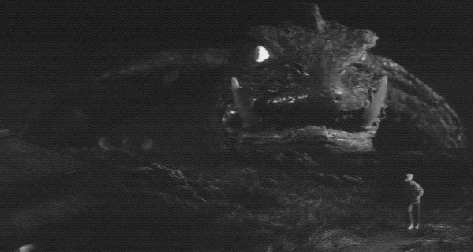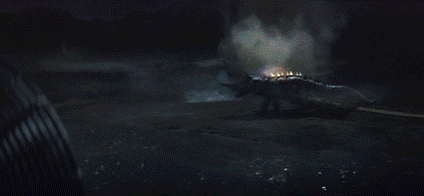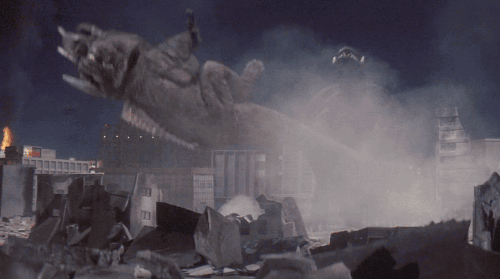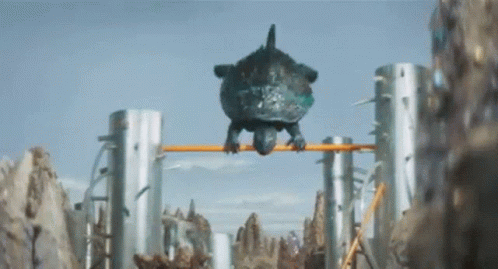
Gamera is, of course, Japan’s second favourite giant monster, one of the staple kaiju of the sixties Monster Boom whose yearly appearance in theatres (and, in the rest of the world, on television) has given him and his films an outsize influence on pop culture. You’d be hard-pressed to find a turtle in any kind of Japanese media who doesn’t fly by spinning around in its shell, and thanks mainly to Mystery Science Theatre 3000, fans of silly movies in the English-speaking world have formed a real soft (shell) spot for the terrapin tornado. Although starting out as Daiei’s answer to Toho’s Godzilla—considering the original movie was in black-and-white even though it was made in 1965, one might say their direct rip-off—the series eventually diverged in tone, even while maintaining a similar monster fight formula. While both monsters are beloved by children in the audience, Gamera was the one that was directly positioned as the “Friend to all Children”, a playful figure who would usually star alongside young actors in increasingly goofy plots, which is a level of direct pandering that Godzilla never really engaged in (at least until it started directly lifting stuff from Gamera in the late sixties and early seventies.) Gamera was even successfully revived in the mid-nineties with a trio of highly-regarded films directed by Shusuke Kaneko and written by Kazunori Ito, which I wrote about years ago.
While I’ve seen some of the movies in the original series, I’ve never had the opportunity to sit down and soak in the entire 1966-1971(+1980) run until I found the whole series available on our old pal, Tubi TV. The experience of running through the entire Showa Gameras (most of them directed by Noriaki Yuasa) has not only provided a more detailed context for the series and its place in monster history, but also demonstrates the wild evolution the series and its title kaiju took over those five years—what you thought you knew about Gamera is only partially true (he is still really neat and also filled with meat, however.) So, in this special extra-length post, I will compactly address each of the seven sequels—yes, it’s time to fire up the old capsule review machine.

Gamera, The Giant Monster (1965)
(EDIT FROM THE DISTANT FUTURE: For completeness’ sake, I have inserted this brief capsule review from a viewing I had over a year after this post was original written. Now all of your Gamera is in one place!)
The original is interesting in that it feels like it’s trying to be a bunch of different monster movies at once. What is the audience supposed to feel about Gamera? The script certainly doesn’t know. He’s treated as a menace for most of the it (and some of his most ludicrous traits, like his flight ability, are viewed with an equally ludicrous awe), except for the one scene where he saves a child, and that child becomes his one supporter for the rest of the movie, undaunted by everything else that happens. It almost feels like a child fan of kaiju films has stumbled into this narrative, and he works directly against the more logical response of the adults, which is actually a quasi-meta angle, although in this case it really only plays into a few scenes. Despite the narrative indecision, the black-and-white look is surprisingly sharp, showing how closely Noriakia Yuasa must have studied the original Godzilla. Things certainly become different after this point, so this movie remains an oddity even in this consistently odd series.

Gamera vs. Barugon (1966)
A very weird beginning to Gamera-as-franchise. This movie is way too long and Gamera is barely in it—plus, there are also no children in it, showing that part of the character was not always part of the plan. In this movie, Gamera is mostly seen as a nuisance (as a continuation of the original, we open with him being shot into deep space, only to turn himself back around and go home just in time to crush a dam), is taken out in a mid-movie fight scene (establishing his propensity for getting his shelled butt kicked, which repeats throughout the series), and then comes back at the very end to act as a deus ex machina. While in tone and structure this seem to be a take-off on Godzilla Raids Again, it actually reminds me a lot of the similar oddness found in Godzilla vs. Biollante—both try to get into a formula that has already been thoroughly mapped out in several Godzilla sequels, but don’t quite have a handle on it, and are oddly paced because of that.
At the very least, once all the jungle adventure and overwrought human drama are over and done with, we’re mostly left with a movie about Barugon, one of the stranger creatures to show up in these movies. With its freezing tongue (as in, the tongue itself sprays icy vapour at things) and ability to shoot a devastating rainbow from its dorsal spines, it cuts a memorable figure. Most of the movie is actually about the humans trying to figure out how to get rid of Barugon with its litany of highly specific weaknesses, and failing over and over again until the movie remembers that Gamera exists. I like the idea that the military has an experimental death ray that they are just willing to loan out whenever. This is also another one of the many kaiju films and television shows that use an exotic South Seas locale, showing just how pervasive that trend was. All of that focus on Barugon really contrasts this heavily with what the movies would become starting with the next one, but it makes sense when you consider that this was the one not directed by Yuasa. On the other hand, this movie does share the other movie’s level of violence: Gamera and the other monsters spurt blood (be it standard-coloured or dark purple) at the drop of a hat, which only becomes more over-the-top as the series goes along, and feels very calculated to appeal to the young boy audience.

Gamera vs. Gyaos (1967)
This is where the series really begins, and is probably the “purest” of the Gamera films, released right at the height of the Monster Boom for maximum impact. From the beginning, the child protagonist believes that Gamera is a friendly force, despite everything that went on in the first two movies—and he is proven right when he is saved from winged terror Gyaos by Gamera, which features the first appearance of the monster glove hand that reappears throughout the series. The pivot in the characterization of Gamera and humanity’s relationship with him, way less gradual than the similar transition that Godzilla undertook, should produce some pretty harsh whiplash, but the film itself is often so silly (with goofy comic relief characters and scenes like a group of reporters escaping in a car that has been torn in half), you never really notice. Considering how light the movie is otherwise, though, Gyaos is actually kind of a scary creature (his very puppet-y design aside), vicious and bloodthirsty and actively eating people—the reboot films very much notice this and take it much farther. Much like Barugon, it not only puts Gamera and humanity through the wringer for most of the movie, but also has a very glaring weakness (Barugon’s was fresh water, Gyaos’ is sunlight) that it frustratingly manages to overcome right until Gamera saves the day. The humans help, of course—they create a bowl of fake blood and then spin Gyaos around to make it dizzy. These are the things that make me love these movies.
Although there is a larger focus on the Gamera-loving kid, there is still quite a few scenes with the adults in this. There is a subplot involving a group of greedy rural villagers who are intentionally blocking the virtuous land developers from building a highway over their homes so they can demand more money from them, which is a hilarious reversal of how those sorts of stories usually go. It might be trying to make a point about “progress” here, but I was way too amused by the very idea to look into it too deeply.

Gamera vs. Viras (1968)
This is another fun entry that unfortunately gets saddled with another recurring trend in this series going forward: the movies’ budgets getting slashed and being forced to reuse footage from previous movies to fill out the running time. This movie isn’t even that long, yet a good ten to fifteen minutes of it are either flashbacks or stock footage being presented to us as if it is part of the story (even when it’s from the monochromatic original film.) It just makes you feel bad for the people making it, because when they get to do something new, they’re clearly firing on all cylinders: the alien menace as portrayed in this film spend most of the time looking like evil surgeons, but we get many scenes of weirdness involving them (detaching limbs, glowing eyes), and while it takes quite a long time for Gamera’s monstrous opponent to show up, the final battle is delightfully brutal (I also love the revelation that the alien “animal” the protagonist kids find is not just the titular monster, but also the leader of the aliens.) This is also the entry that begins the trend of having two child protagonists, a Japanese one and an American one, clearly there to appeal to international audiences—he speaks in English every once in a while, and while he was apparently not an actor, his line readings are certainly better than the actress playing his mother. Early on, too, you get a scene where the two kids swim alongside Gamera in a submarine, and it’s the kind of really fun, lighthearted scenes that I think define what stands out about these movies at there best—the other being when the UN decides to give in to the alien’s demands because they have the two kids on their spaceship, even when the kids themselves say they are willing to sacrifice themselves to protect the Earth. Priorities, people!

Gamera vs. Guiron (1969)
About on par with the other two, but the plot is so threadbare that you could almost see them cutting it down into an episode of an Ultraman style TV show. Even though Gamera vs. Viras apparently happened, no one believes in the existence of aliens, until the prerequisite boy duo find an abandoned spaceship in a field, which automatically flies them to another planet when they step inside (and Gamera is unable to grab the ship and take them back. Did I mention that Gamera can go cruising in outer space whenever he wants, too?) There, they find a dying alien civilization and its only survivors, two women who protect themselves from intruding monsters (I.E. Gyaos spray painted silver) with their own monster, the knife-headed Guiron. The two aliens are, in fact, planning to eat the kids’ brains, and then go back to Earth to eat everyone else’s brains, I think? It’s almost refreshing to have villains with such straightforward motivation. There are intermittent scenes that cut back to the one boy’s younger sister trying to tell their mother and a police officer (played by a Japanese comedian who is there to basically insert his routine into the movie) what happened, and none of these scenes really go anywhere or add to the plot in any significant way.
For some reason, this is the only movie in the series where Tubi has the dubbed version, which means that you don’t get to see the single best part, which is Guiron chopping the Gyaos into pieces (thankfully, Youtube has it there in high quality.) Guiron is such an amazingly blunt monster concept, and his entire gimmick is to inflict as much pain on Gamera as possible—the parts where you watch Gamera try to pull shurikens out of its arms and legs are as amusing as they are kinda wince-inducing. In a lot of ways, this is one of the sillier movies in the series, which is really saying something.

Gamera vs. Jiger (1970)
This one throws you into the mix really quickly—Gamera shows up early, and the first fight between the two monsters happens not long after. This one also involves a mysterious island, with Gamera trying to prevent a group of western dimwits from removing a large totem so they can display it at the real life Expo ’70, a world’s fair that was held in Osaka (we not only get to see a lot of footage of the Expo, but the adults in the movie are probably more concerned with protecting it than they are with protecting the actual city.) They decide that Gamera’s interference is him just being a jerk, but wouldn’t you know it, the thing was actually keeping a thorny dinosaur named Jiger (which we first learn about when a representative from “Wester Island”—the only black actor to appear in any of these movies—begins ranting at them in what is very likely a made-up language) at bay. Jiger has a wide array of odd abilities—horns it can shoot, rockets that allow it to fly, a heat ray very similar to Barugon’s rainbow ray that turns soldiers into skeletons, suction cup feet, and in what is probably the most disturbing thing to appear in any of these movies, a tail stinger that it uses to lay its egg into Gamera’s lungs, seemingly killing him (that turtle really has it rough in these movies.) Thankfully, Jiger also has a habit of falling asleep at convenient times, allowing the protagonist kids to resurrect Gamera by taking another mini-sub and entering Gamera’s body to take out the baby Jiger now living parasitically inside him, so we get a low-budget riff on Fantastic Voyage to vary things up. Eventually, Jiger is revealed to be weak to high frequency noise, which the object they removed from the island provided by basically being a giant flute. Like Gamera vs. Guiron, this feels like it could have been an episode of a TV show, but is otherwise still fairly enjoyable, especially when you get to the sub-body horror stuff.

Gamera vs. Zigra (1971)
Things really go off the rails in this one in pretty spectacular fashion, making it probably the single most baffling movie in the series. Even though it apparently takes place in a future where space travel is a normal thing, most of it is spent at a real Japanese marine life park, where we get to see entire exhibitions of seals and orcas. The two kids (who apparently not only live at the park, but their families appear to share the same quarters for some reason?) are precocious to the point of madness, asking weird questions and reacting to things in an utterly nonsensical manner. Scenes of genuine tragedy both big (entire cities destroyed by earthquakes—which we only get to see the aftermath of—with many lives lost) and small (the families of the protagonists thinking that they’re going to die at the bottom of the ocean) are contrasted with comedy scenes where an animal keeper fights with a hotel manager about fish supplies. A shaggy island hermit appears in one scene and is never seen or heard from again. The fish monster menace of the title goes from pure fish form to guy-in-a-suit walking on land at the drop of a hat. There’s a long Scooby-Doo chase sequence with funky background music in the middle of the movie. There’s a semi-frequent environmental message shoehorned into the dialogue and into the origins of the new alien enemies, but the only real consequence this theme has on the story is that the chemical pollution in the oceans make Zigra grow larger (this released in the same year as Godzilla vs. The Smog Monster, so it was just the mood at the time.) At one point, Gamera plays the dorsal fins of Zigra like a xylophone and dances around, right before torching his adversary to death. As the final film in the original series (…sort of) due to the bankruptcy of Daiei, this kind of off-kilter nonsense either shows a series in terminal decline being mercifully put down, or a portent of a stranger things to come that we unfortunately were robbed of. In either case, what a way to go…

Gamera: Super Monster (1980)
…if it were not for the existence of this movie, which is barely a movie and made entirely to fulfill a contractual obligation. This is essentially a movie-length clip show, with all of its actual action taken directly from all the other movies, with a low-rent TV show filmed in between them in order to fill out the running time. They don’t just reuse old Gamera footage either: there are some bits obviously taken from the anime Space Battleship Yamato and Galaxy Express 999, which is especially jarring. The only new footage of Gamera is a weirdly blurry puppet that can’t actually do anything other than fly around and open and close its mouth. This is a pretty ignoble send-off for a beloved character, and evidently Yuasa knew it, so he intentionally added in the ending where Gamera sacrifices himself (which we don’t actually get to see, naturally) to spare the monster further embarrassment.
There are moments of weird enjoyment to be found here, as well as details that certainly place it in 1980—for example, the alien spaceship’s not-so-subtle resemblance to the Star Destroyer from Star Wars (complete with an opening shot underneath the ship as it passes by), the super-powered alien Space Women in their Superman outfits and Pumaman-level flying special effects, and a laughably unearned swipe at Godzilla’s then-ongoing hiatus when Gamera casually blows over a sign with him on it. The plot itself has a meta quality to it that at least initially seems interesting—this takes place in a world where Gamera is fictional, and the main kid is a fan (there a few scenes where his friends and him pore over an issue of Weekly Shonen Jump, pointing out a clear Gamera reference in one comic and then talking at length about Kinnikuman for no particular reason at all), who is not only given a pet turtle by one of the Space Women (who takes on the guise of a pet shop owner), but gets to see his turtle turned into Gamera by them in order to protect the Earth from reused footage from the sixties. There is something very odd about a young boy who spends most of his time hanging out with adult women, which is only made more eyebrow raising when he brings an unconscious woman home, has her stay in his room, and not only is his mom totally okay with it, but the thing she says when the woman wakes up is “He’s always wanted a sister!” Apart from that, the one scene of pure ebullience to be found in this, one that reminds you of how charming these movies were once upon a time, is when the kid plays a song about Gamera on his electric organ to his new pet turtle—having a bond between a child and an animal, whether it be a regular one or a giant, is the heart of the whole thing, and even if Super Monster ended the series for a good long while, I think the true spirit of Gamera was carried on by its kaiju descendants (especially the ones in the Pokemon vein) and the rest of culture.

